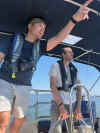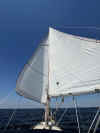We arrived safely, albeit late, back in the barn on September 16th. The first days we enjoyed sunshine and light winds, but the Weather Witches had it in for us on the last day. We spent the last night in the idyllic Chesapeake Bay Maritime Museum. The harbor master put us in a premium slip on the lawn of the museum. We felt honored, even if there werenít many other boats. The best part was that we had enough coverage to dock and undock without any problems, even though in the morning it was already blowing 15 knots. We knew it was going to be a rough day so we skipped going out for breakfast, put our reef in and left the marina before 08:00AM.
Tacking out of St Michaels is always tricky because of the shapes of the shallows, they are not tongue-shaped but formed in the shape of hooks, at least that how it seemed. That means that when you tack at the moment it gets shallow, letís say below 6 feet, you sail into the hook, suddenly hitting 3 feet of water. Itís mud, so not a problem for the IPís, but still, a challenge.
We did not experience any heavy winds in the previous days so I deemed it essential to add this experience to our already broad spectrum of exercises.
Another good experience was the wait for the Kent Narrows Bridge to open. We tried to time our approach but still arrived with 10 minutes to spare. Fortunately the water in front of the bridge was shielded by buildings, this meant we had no problem circling for a few brief moments. The wind didnít start blowing for real until after we crossed that bridge. It must have been blowing gale-force winds at some point because we could barely make any headway on the engine. We went through the bridge at 13:00 hours and didnít arrive at Lankfordís poop-dock until 16:30.
The day before we sailed in from Annapolis to St. Michaels. The guys were totally on their own that day in steering and navigating. It was a smooth ride as expected, unfortunately, there wasnít enough wind to sail. Before we left the stateís capitol we took some time practicing picking up a mooring ball. The night before the basin was much more crowded with vessels; too crowded to take some time to play around with the balls.
Underway we came up with a game of sorts, the trash mob; every time we saw an empty bottle, or a HBD balloon, someone would yell, man over board! At this point we performed the preferred MOB procedure to pick up the trash and take it with us. Itís a small thing to do, but I think it is important for the students to understand that the universe extends beyond the lifelines, and that we all are responsible for keeping our waters clean.
The Annapolis approach was almost as busy as the one in Fairlee Creek, but more spread out. We had to circumnavigate the Navyís sailing team practice, there was the harbor excursion boat of course, the Northwind, and a plethora of vessels anchored so close to the mooring field that if I was the harbor master, Iíd tell them to pay the $35 as well.
On our way to Annapolis we took some time to go over the safety drills. In front of Tolchester Marina a engine failure was called. We floated to shallow water at a safe distance from the main channel and dropped anchor. We checked out engine to figure out what was wrong. We decided it was a blockage of the cooling water intake which could be resolved by either jumping in the water or pulling off the hose from the seacock.
We then looked as possible scenarios for broken fore and back stay, and even side stays. The boat has multiple halyards we can use to rig an emergency fore or back stay. We then simulated a fire and a medical emergency to close it off with an anchor that was stuck in a crabline. To resolve this we used the stay sail halyard to lift up the anchor.
We came out of Fairlee Creek in the morning. Fortunately it wasnít as busy as the night before when multiple motorboats were coming in and out of Ąthe cut.Ē This is a narrow inlet that runs right next to the beach. And when I say right next to it, I mean, right next to it; you are almost close enough to reach out and grab a can of soda from the person on the beach. When we entered the night before, it was eerily quiet on board. Squeezing in there the first time with a current running and boats coming in and out isnít for the faint of heart.
Before we left our anchorage, we practiced anchoring with a second anchor. We talked about the variety of options and the limitations of using multiple anchors.
The sail from Lankford Bay Marina to motor to the bay. It was a gorgeous day, 75ļ lights winds from the south. We decided to raise the sails, put on the preventer and sail downwind, wing on wing for a few hours before we made the turn around the point at Fairlee.
In conclusion, a few side notes. We found a part of floating dock made of plastic but too big to drag along. The fish traps are a dangerous hazard, especially at night and when sight is not hundred percent due to rain for instance, or the setting sun. Our cleats are designed by the famous American naval architect Herreshof, I did not know that but thought that was an interesting
tid-bit.
Happy sailing!
Captain Gerald van Wilgen









